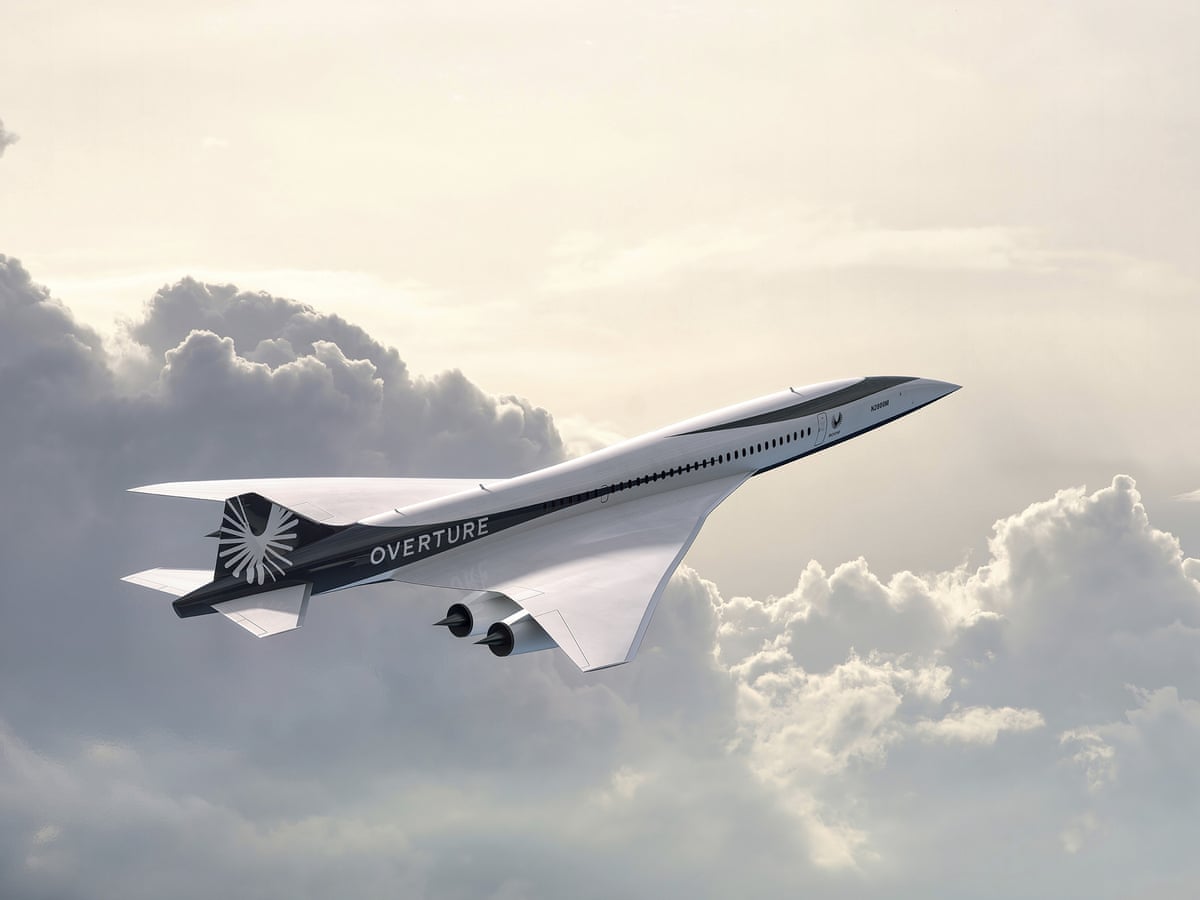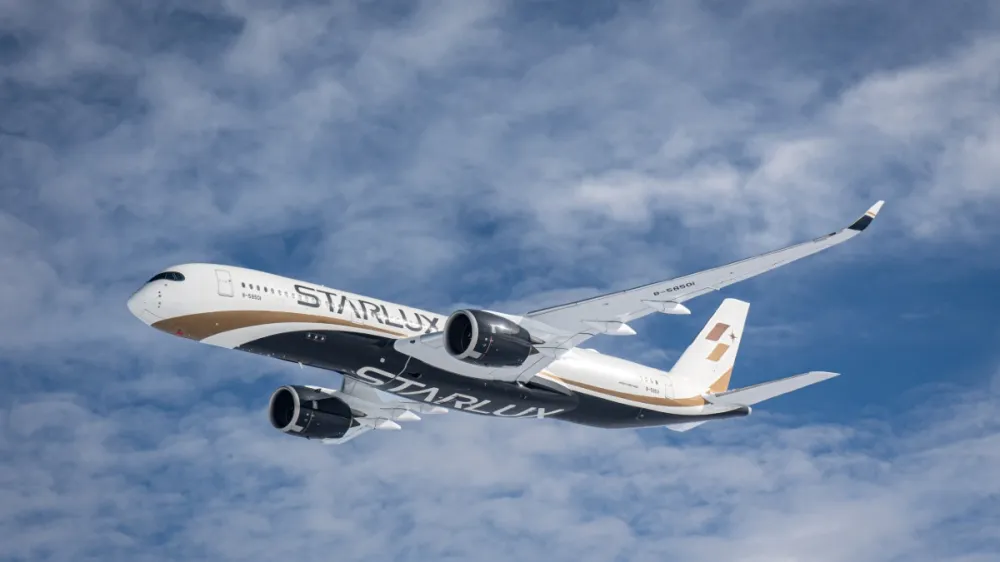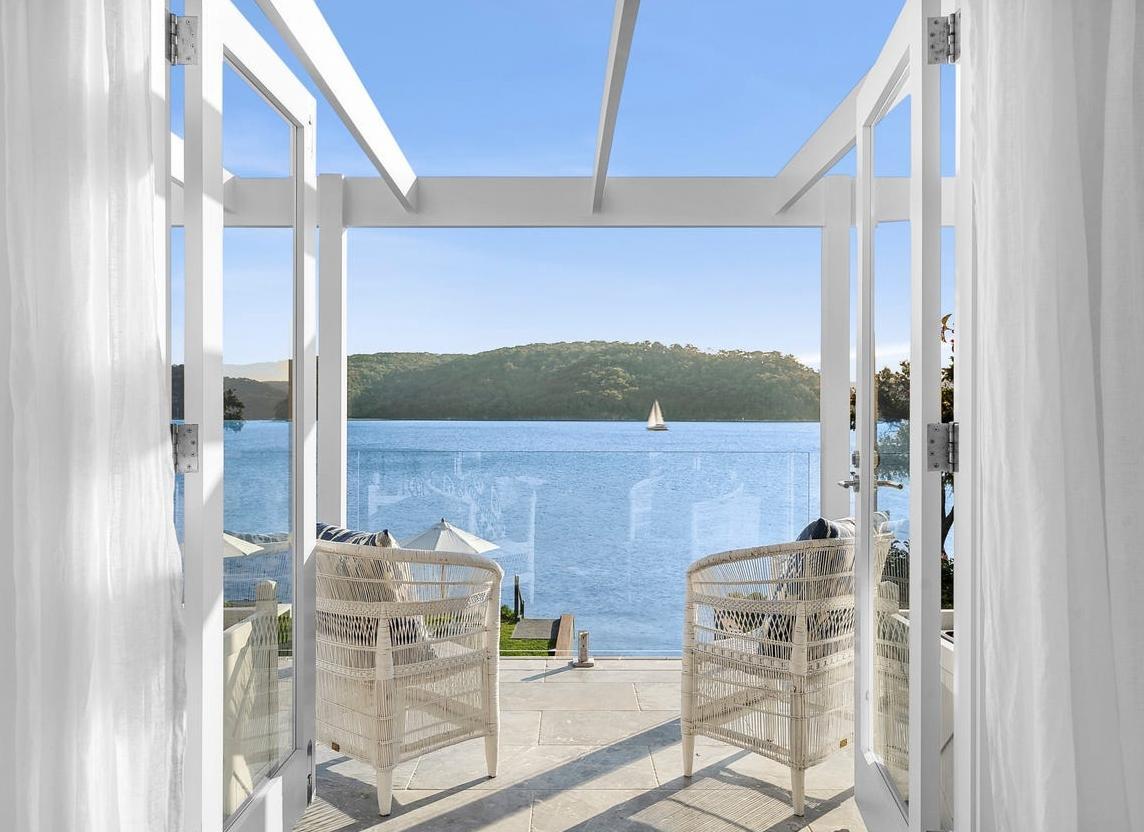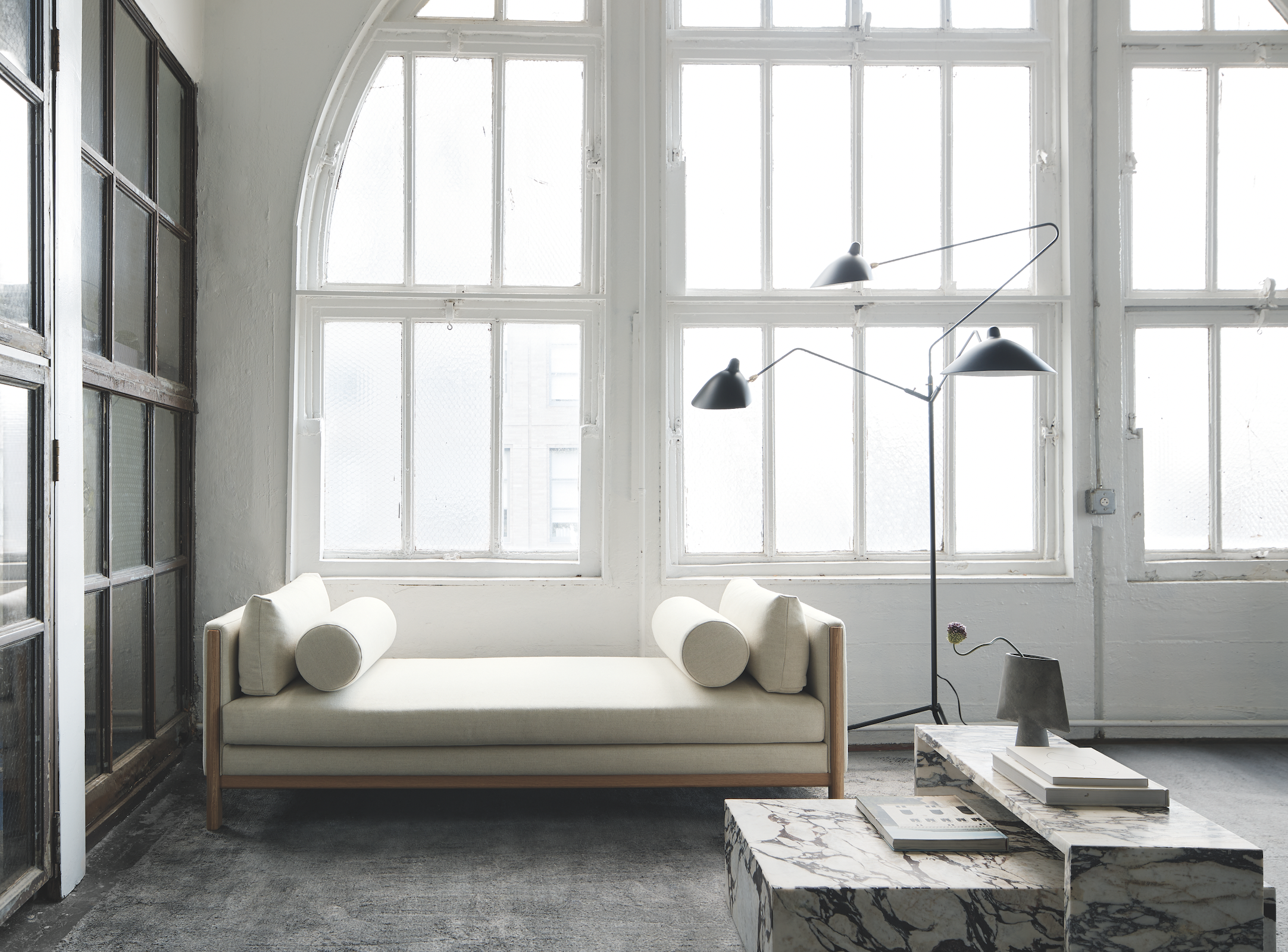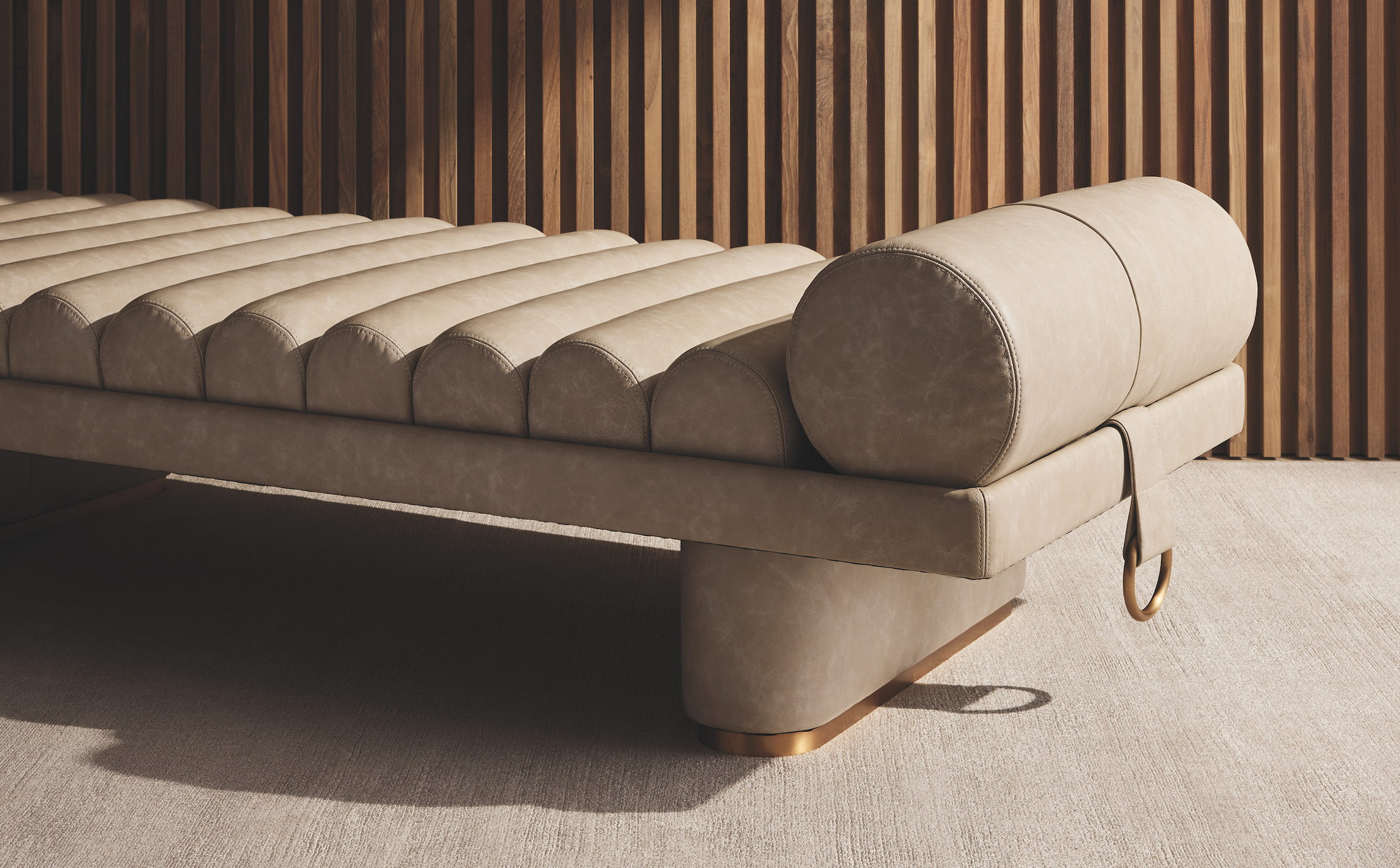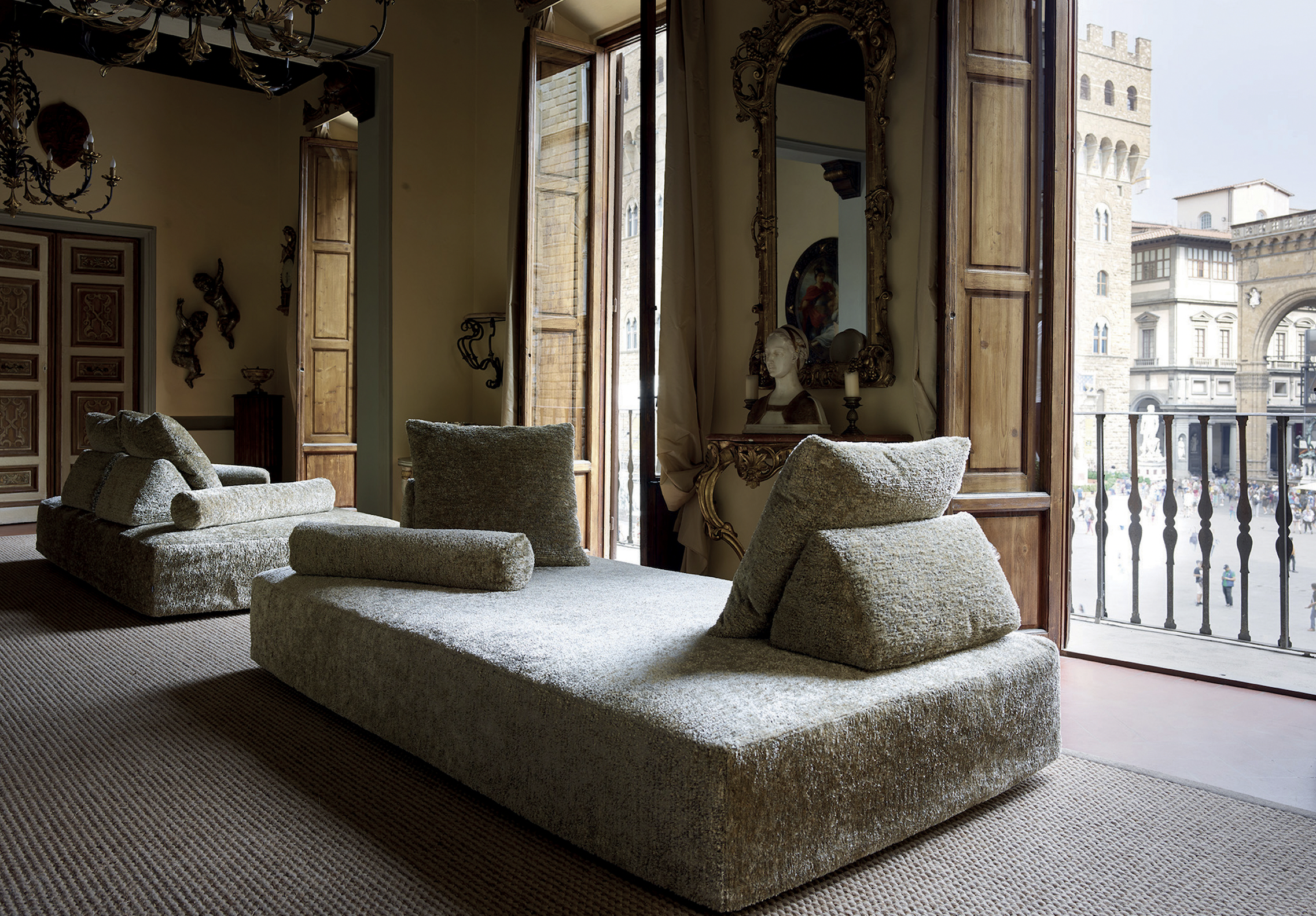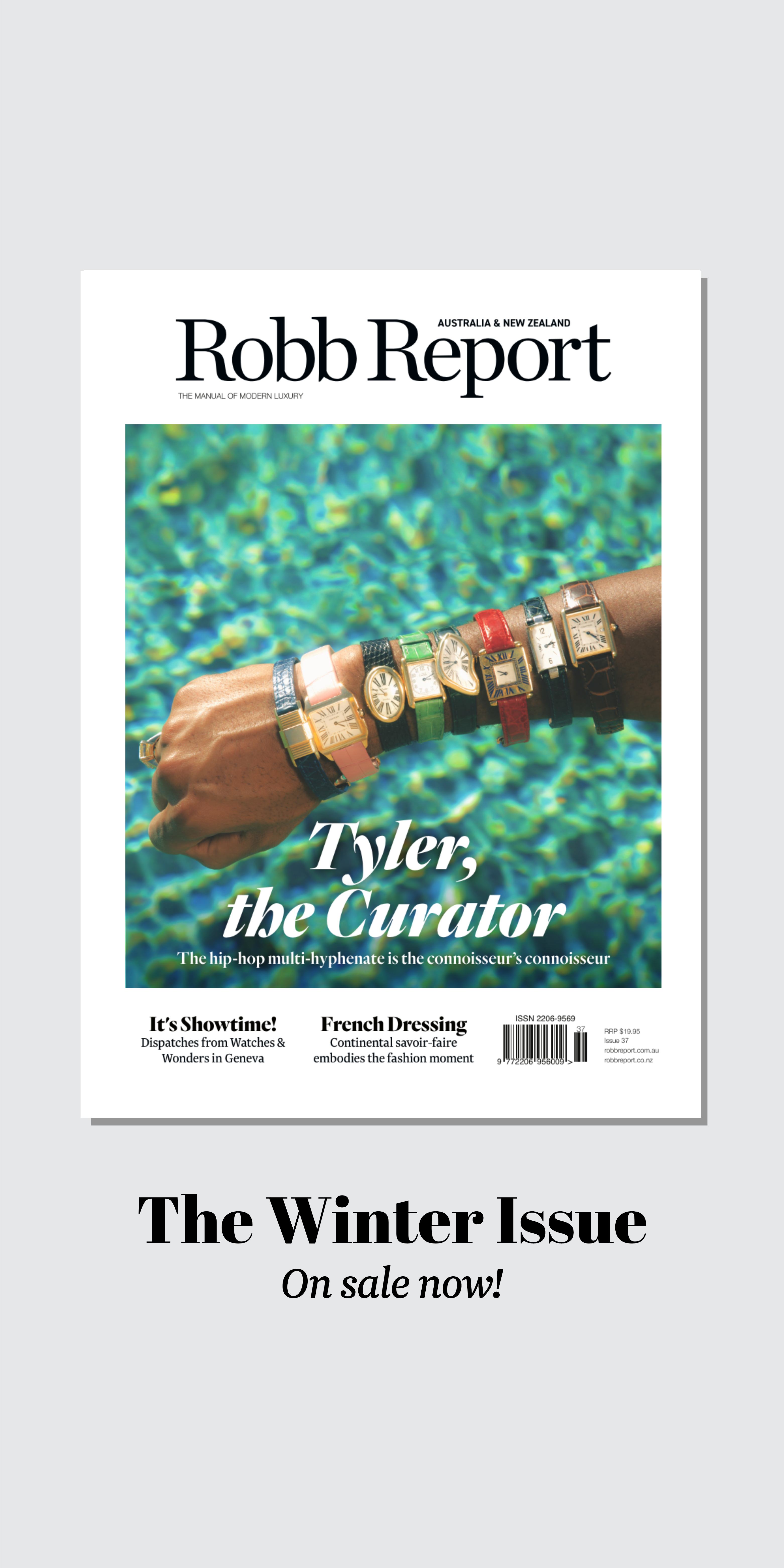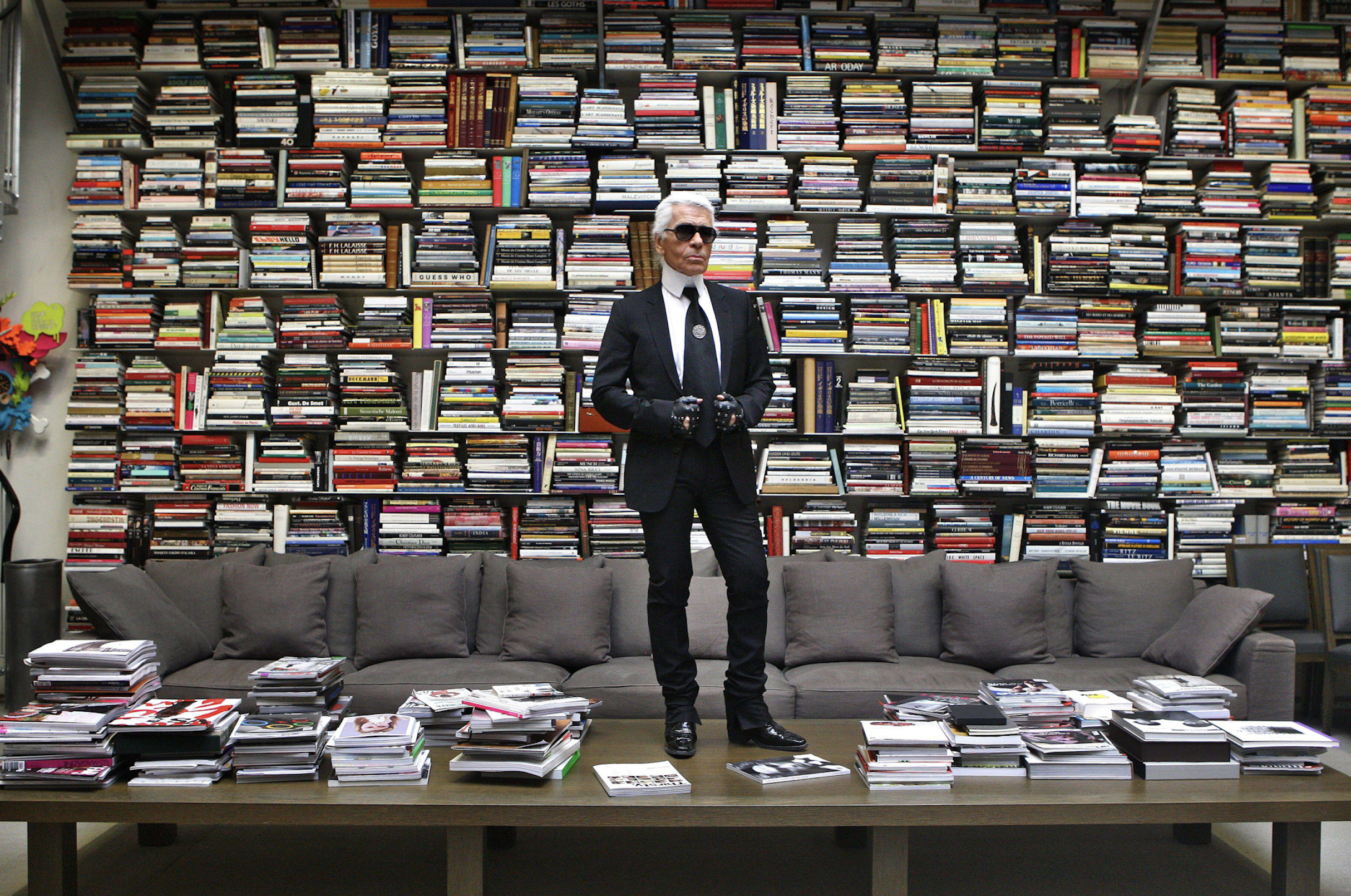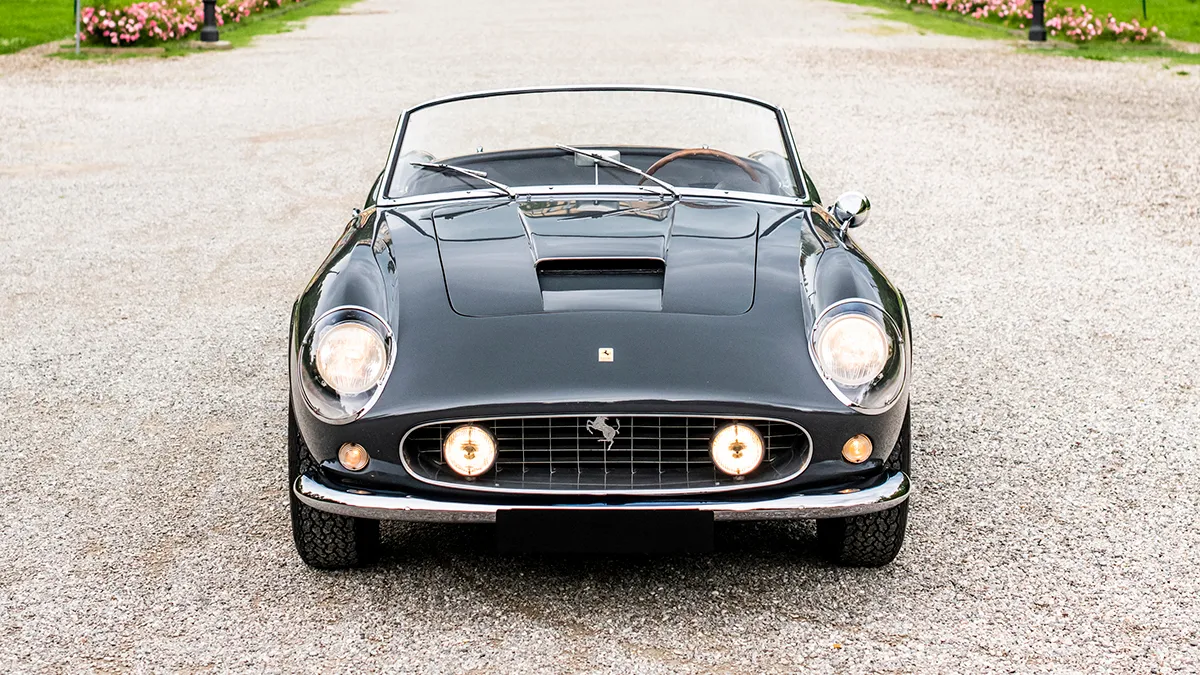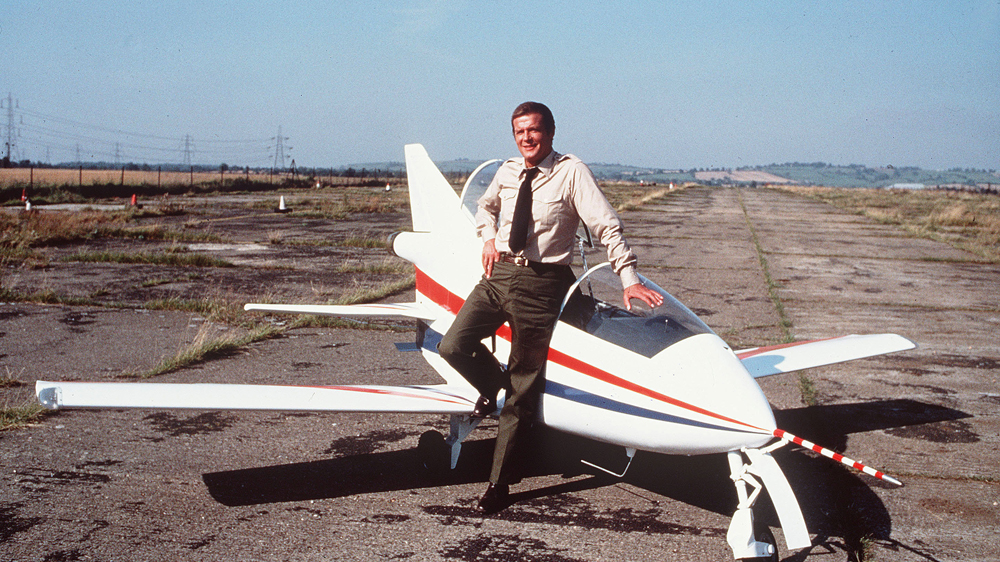
9 famous collectible aeroplanes you should have bid on at auction
Each of these iconic aircraft went on the auction block, and some sold for what we now know is a bargain price.
Related articles
Whether it’s a car, home, jewellery, or piece of art, if an item going to auction has some kind of celebrity cachet, chances are good that it will garner additional attention—and perhaps draw higher bids. Consider, for example, the 1962 Lockheed JetStar that Elvis Presley owned briefly in the mid-1970s. After the King sold the aircraft in 1977, it sat on a runway in New Mexico for more than 35 years, collecting dust and rust. Nevertheless, when the plane went to auction in 2017, it sold for US$430,000.
Even though the price was well below the US$2 million presale estimate, it was still a lot to pay for an aircraft that couldn’t fly and needed a complete interior and exterior restoration. And, in fact, it was too much to pay. It seems the new owner experienced buyer’s remorse, because the JetStar went back on the block this past summer. There’s no word from the auction company, IronPlanet, on whether the seller made back his money.
The JetStar is not the only Elvis plane to go to auction, and it’s not the only one with a celebrity or pop-culture connection that helped it fetch plenty of notice, though not necessarily the owner’s asking price. The following aircraft became famous because of a role they played in a movie, on TV, or in real life, and at one time or another, each was available to the highest bidder.

Elvis Presley’s Lisa Marie plane at Graceland
Photo: DreamArt123/Shutterstock
Lisa Marie and Hound Dog II
– On the block in 2015
– Sold together for a reported US$15 million
Elvis fans breathed a sigh of relief in 2015 following the sale of his two jets—Hound Dog II and the Convair 880 that Presley named Lisa Marie after his daughter—because the new owner reached a “permanent” agreement to keep the aircraft at Graceland in Memphis, where they have been loved tender since 1984.
Elvis purchased the plane that would eventually bear the name Lisa Marie—a Convair 880 narrow-body airliner—from Delta Airlines in 1975 for US$250,000. He spent another US$350,000 refurbishing it. The custom interior includes a queen-sized bed, a bathroom with gold faucets and a gold washbasin, a videotape system linked to four televisions, a stereo system with 50 speakers, and a conference room. The tail section of the plane is emblazoned with the initials TCB—taking care of business. The plane last carried passengers in 1977, when it flew Priscilla Presley and George Hamilton, a good friend of Elvis, from California to his funeral at Graceland.
Like the plane in New Mexico that once belonged to Elvis, Hound Dog II is a Lockheed JetStar. Elvis bought it for about US$900,000 in 1975 while waiting for the refurbishment of Lisa Marie to be completed.

WWII British Spitfire
Photo: John M. Dibbs
World War II British Spitfire
– On the block in 2014
– Sold for an undisclosed price
The unrestored Mark IX Spitfire was one of eight World War II fighter planes that appeared in the 1969 film Battle of Britain. They belonged to Wilson Connell “Connie” Edwards, a pilot who later made his fortune in the oil, ranching, and stone businesses. Not a man afraid of old-fashioned bartering, he coordinated the movie’s flying stunts and took the aeroplanes as payment. Before selling them, Edwards kept the aircraft in a hangar on his private airfield in Texas for more than 40 years. The Spitfire in question, which an unidentified British collector acquired for an undisclosed price, is particularly notable because it flew in the actual Battle of Britain.
Edwards had intended to give the aircraft to his son, but the younger man was killed in a traffic accident. The total asking price for the eight aircraft was a firm US$15 million, and according to Platinum Fighters, the company that handled the sale, Edwards received more than that sum.
In 2015, one year after that sale, a restored World War II Spitfire that had been shot down over northern France in 1940 and discovered in the sands of Calais 40 years later sold at a Christie’s auction in London for US$4.8 million—the most ever for an aircraft at auction. The presale estimate was only US$3 million. The proceeds from the sale were donated to the Royal Air Force Benevolent Fund and the wildlife charity Panthera.

Indiana Jones and The Last Crusade biplane
Photo: Prop Store
Indiana Jones and the Last Crusade Biplane
– On the block in 2017
– Unsold
This third installment of the Indiana Jones franchise was apparently more popular with moviegoers than the film’s Stampe et Vertongen SV.4 biplane was with collectors. The 1989 film became the first to sell US$10 million worth of tickets in a single day; the auction company that conducted the sale of the plane last year, Prop Store Entertainment Memorabilia, expected to draw bids of US$27,000 to US$40,000, but the aircraft went unsold, indicating that the bottom end of the estimate range wasn’t reached.
The biplane was offered while sporting Royal Air Force markings rather than the Luftwaffe livery it displayed in the Last Crusade. This is because it was wearing makeup from its last film role (in what was also perhaps Brendan Fraser’s last good film), 1999’s The Mummy. Perhaps the mummy’s curse afflicted the biplane as well as Fraser’s film prospects.
In the Last Crusade sequence featuring the biplane, Harrison Ford and Sean Connery are aboard, trying to elude their Luftwaffe pursuers. Connery, as Indiana’s father, Henry Jones Sr., inadvertently shoots bullets from a machine gun through the aeroplane’s tail section and then tells Indiana, “Son, I’m sorry. They got us.” The prop for the bullet-ridden tail section was offered as a separate lot.

Out of Africa biplane
Photo: Courtesy of Bonhams
Out of Africa Biplane
– On the block 2013
– Sold for 201,250 euro (about US$280,000 at the time)
The airworthy 1929 De Havilland Gipsy Moth biplane flown by Robert Redford’s character in the seven-time Oscar winner from 1985 was expected to sell for only about 103,000 euro. Instead, the price rose to nearly double that mark before the hammer dropped at the 2013 Bonhams auction. The price, the equivalent of about US$280,000 at the time, was the most ever paid for a Gipsy Moth. The winning bid came from a buyer in Kenya, where the movie was set.
The plane is featured in a four-minute-long romantic scene in which Redford is the pilot and his passenger is Meryl Streep, who, of course, was nominated for a best-actress Oscar. They fly over the Kenyan savannah, holding hands. Alas, later in the film, Redford’s character is killed when (spoiler alert) he crashes the plane en route to be with Streep’s character.
The plane, painted bright yellow, was in superb condition when it was sold and came with a permit to fly.

Fantasy Island plane
Photo: Branson Auction
Fantasy Island Plane
– On the block in 2016
– Sold for US$275,000
The 1967 Grumman Widgeon, whose arrival at the start of each episode of Fantasy Island was heralded by Tattoo shouting, “De Plane! De Plane!” fell on hard times after (spoiler alert) the show concluded its eight-year run in 1984. According to various reports, the aircraft passed through the hands of a series of owners after Fantasy Island went off the air. It crashed in a swamp on at least one occasion and was involved in a gear-collapse accident. At least twice it was confiscated by drug-enforcement authorities (it was, after all, the ’80s) and sold at auction. However, it was refurbished in the late 1990s and presented on the air-show circuit throughout the Midwest.
The aircraft is not an authentic Grumman Widgeon. It’s a Société Construction Aéro-Navale Type 30, a license-built copy of a Grumman Widgeon. It was built in Rochelle, France, in 1951, eventually disassembled, and stored until 1967, when it was imported to the United States and reassembled with new engines.
Nearly all of the footage of the plane used throughout the series was shot in a single day. When the guests arrived at the island at the start of each episode, they climbed out of a plywood mock-up of the back of the plane.

Roger Moore in Octopussy
Photo: Danjaq/EON/UA/Kobal/REX/Shutterstock
Octopussy Microjet
– On the block in 2014
– Sold for US$275,000
Before the Bede BD-5J starred in the opening sequence of the 1983 James Bond movie Octopussy, in which Agent 007 uses it to evade the bad guys and a heat-seeking missile, the aircraft had already made a claim to fame. At only 163kg, it was listed by Guinness World Records as the world’s lightest single-engine jet.
A propeller version of the aircraft was developed in the late 1960s by the Bede Aircraft Corporation and sold in the early 1970s as a kit plane before the company went bankrupt in the mid-1970s. The jet-powered version, the BD-5J, which was also known as the Acrostar, could achieve 480km/h. Two examples of the aircraft were flown in air shows throughout the 1980s by Coors Light—which called the planes, naturally, Silver Bullets—and another appeared in Bud Light commercials. The aircraft have been involved in several fatal crashes, including one in 2013 involving a BD-5J that was part of Red Bull’s Flying Bulls racing team.
In addition to its role in Octopussy, the BD-5J made a cameo in the later Bond film Die Another Day, in which it is seen hanging on the wall of Q’s workshop.

“The Miracle on the Hudson”
Photo: Justin Lane/EPA/REX/Shutterstock
Miracle on the Hudson Airbus A320
– On the block in 2010
– Sold for an undisclosed price
The Airbus A320 that Tom Hanks (or, should we say, Captain Chesley “Sully” Sullenberger) successfully ditched into the Hudson River in 2009 went to auction in 2010 with the expectation that it would be sold for scrap metal. A similarly scrapped Airbus 310 had recently sold for US$2.6 million and reportedly earned its new owners US$4 million when they broke it up and sold it for parts.
The engines on U.S. Airways flight 1549 lost power following a bird strike, and by landing the plane on the river, Sully managed to save all 155 passengers and the crew. The airliner eventually was hoisted out of the river and onto a barge. Its wings and tail were cut off so that the fuselage could be hauled on a flatbed truck to a warehouse in New Jersey, where National Transportation Safety Board inspectors spent nearly two years trying to figure out what went wrong and whether Sully did the right thing by landing in the Hudson.
At the auction, instead of a salvage company placing the winning bid, the plane was acquired by the Carolinas Aviation Museum for what is reported to have been a bargain price. The museum had the plane transported to its home in Charlotte, North Carolina, the destination of Flight 1549 on the day of its splash landing. It reattached the wings and tail, restored the interior, and now has the aircraft on permanent display. According to the museum, the number of daily visitors more than doubled in the autumn of 2016, after Sully, the film re-creating the splash landing, was released.

President Dwight Eisenhower and First Lady Mamie Eisenhower exit “Air Force One” in 1953
Photo: US Air Force
The First Air Force One
– On the block in 1970
– Sold for US$35,000 with four other Lockhead VC-121 aircraft
The Lockheed VC-121 that was known as Columbine II, Dwight Eisenhower’s presidential plane and the first to be designated Air Force One, has now been completely restored, but at one time it was on the verge of becoming a crop duster or scrap metal.
The Air Force One call sign was established in 1953 following an incident in which an Eastern Airlines commercial airliner accidentally entered the same air space as Columbine II. The airliner was flight 8610, and the president’s plane was flying under the call sign Air Force 8610.
The aircraft, serial number 48-610, was retired in 1968 and sent to storage at Davis-Monthan Air Force Base in Arizona. Two years later, it was part of a US$35,000 five-aircraft auction sale to Mel Christler, a Wyoming businessman who bought the VC-121A planes from the Air Force with the intention of converting them into crop dusters. He didn’t know that one of those planes was the original Air Force One.
Christler converted the other four VC-121 aircraft, but not Columbine II. Its landing gear was faulty because it had been replaced with parts from a different plane model. The owner therefore decided to instead use the plane to supply the other four with spare parts. In 1980, he was on the verge of cutting up the aircraft and selling it as scrap when the Smithsonian Institution—like the deus ex machina in a schlocky movie—contacted him in time and informed him of serial number 48-610’s true identity.
The plane’s current owner acquired it in 2015 and began a full restoration in 2016.
Subscribe to the Newsletter
Recommended for you
These Next-Gen Supersonic Jets Want to Replace the Concorde. Will They Ever Take Off?
Skeptics think not, but a core of true believers are inching forward with new designs and test flights.
June 14, 2024
Asia Just Got a New Luxury Airliner, Here’s What It’s Like Onboard
Starlux wants to be “the Emirates of Asia,” but those are pretty big shoes to fill. We take a roundtrip flight from San Francisco to Taipei to sort reality from hype.
By Rachel Dube
April 8, 2024
You may also like.
By Josh Bozin
24/07/2024
You may also like.
5 Lounge Chairs That Add Chic Seating to Your Space
Daybeds, the most relaxed of seating solutions, offer a surprising amount of utility.
Chaise longue, daybed, recamier, duchesse brisée—elongated furniture designed for relaxing has a roster of fancy names. While the French royal court of Louis XIV brought such pieces to prominence in fashionable European homes, the general idea has been around far longer: The Egyptian pharaohs were big fans, while daybeds from China’s Ming dynasty spurred all those Hollywood Regency fretwork pieces that still populate Palm Beach living rooms. Even Mies van der Rohe, one of design’s modernist icons, got into the lounge game with his Barcelona couch, a study of line and form that holds up today.
But don’t get caught up in who invented them, or what to call them. Instead, consider their versatility: Backless models are ideal in front of large expanses of glass (imagine lazing on one with an ocean view) or at the foot of a bed, while more structured pieces can transform any corner into a cozy reading nook. Daybeds may be inextricably linked to relaxation, but from a design perspective, they put in serious work.
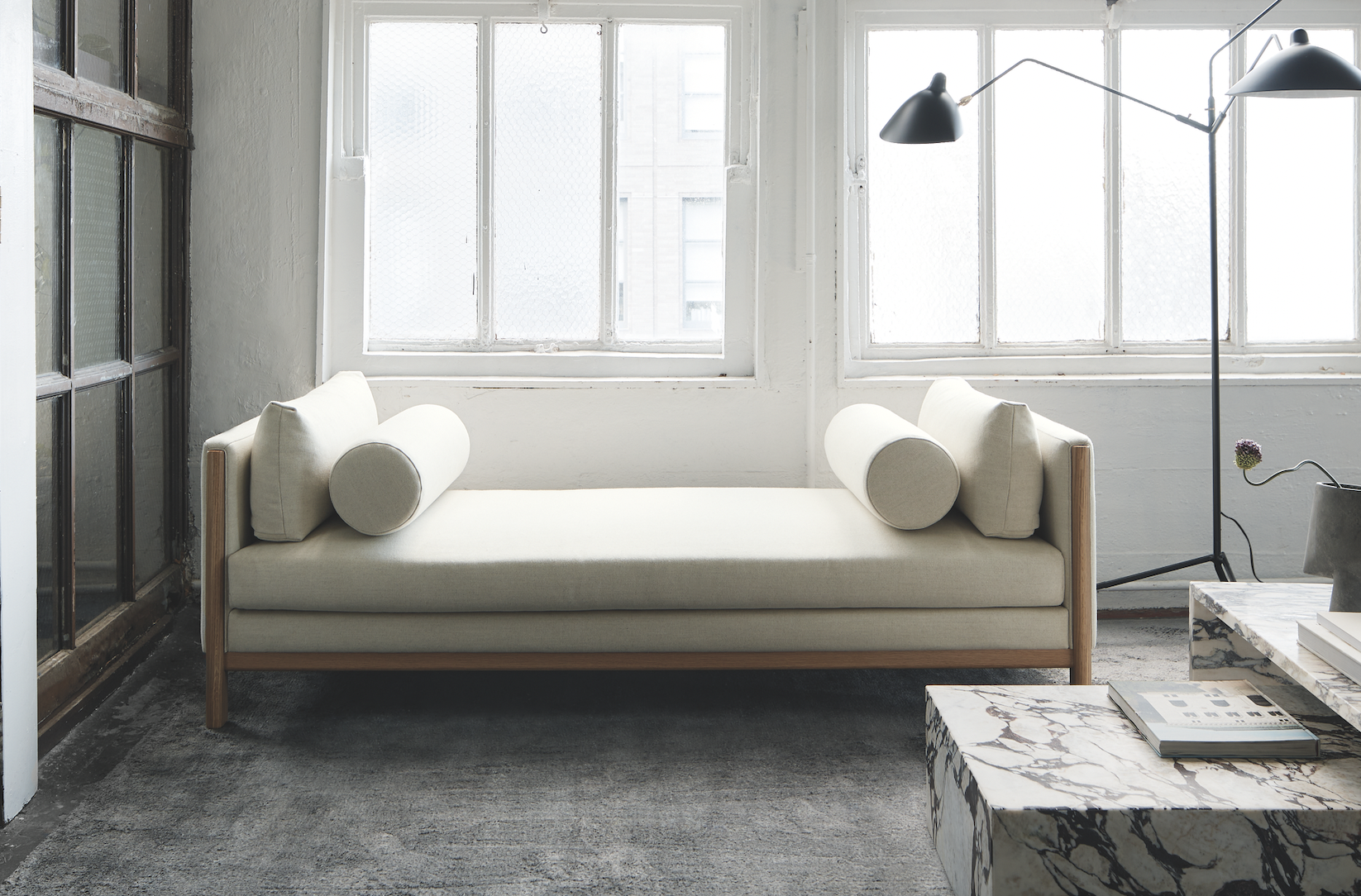
Emmy, Egg Collective
In designing the Emmy chaise, the Egg Collective trio of Stephanie Beamer, Crystal Ellis and Hillary Petrie, who met as students at Washington University in St. Louis, aimed for versatility. Indeed, the tailored chaise looks equally at home in a glass skyscraper as it does in a turn-of-the-century town house. Combining the elegance of a smooth, solid oak or walnut frame with the comfort of bolsters and cushioned upholstery or leather, it works just as well against a wall or at the heart of a room. From around $7,015; Eggcollective.com
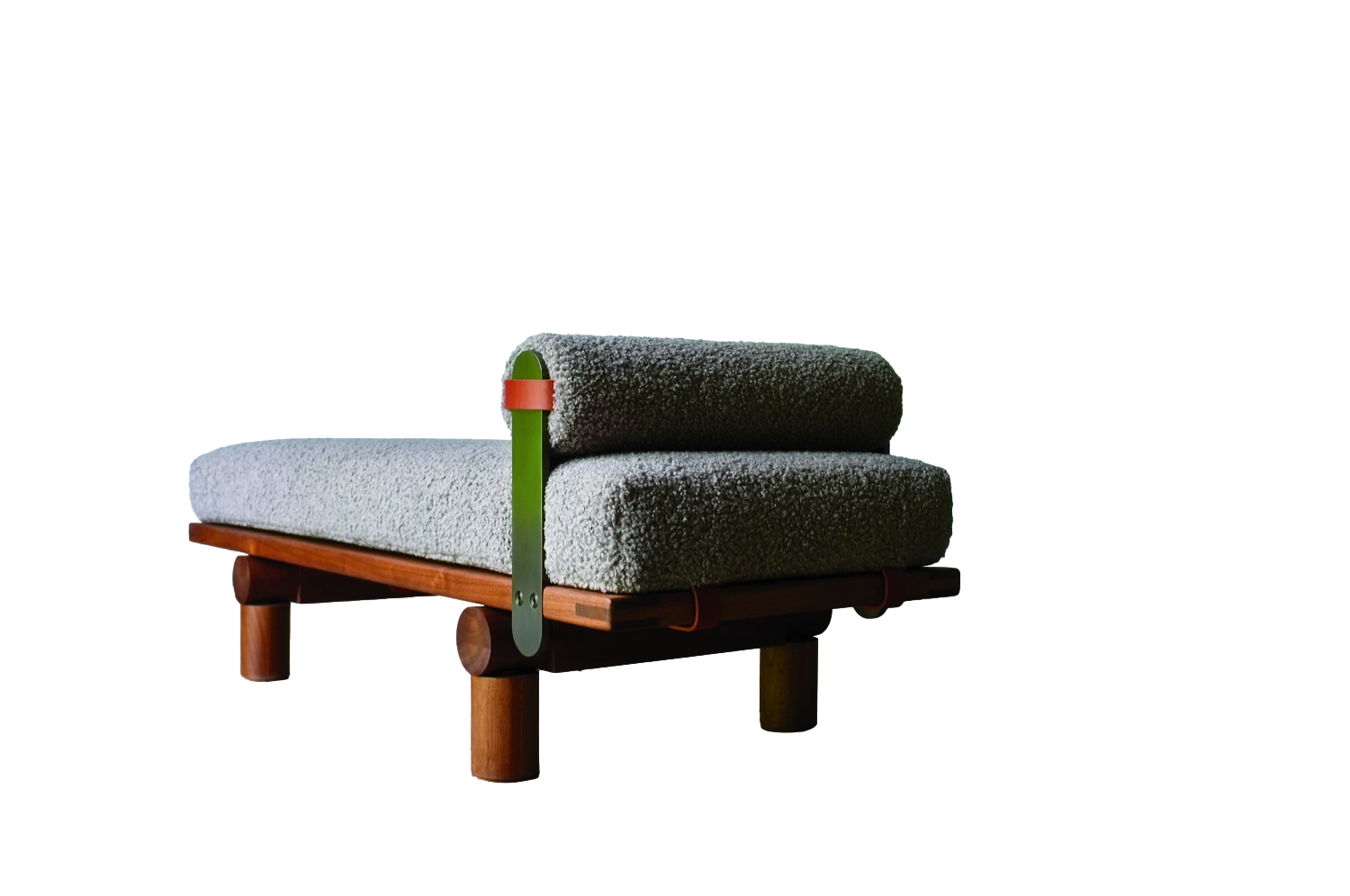 Plum, Michael Robbins
Plum, Michael Robbins
Woodworker Michael Robbins is the quintessential artisan from New York State’s Hudson Valley in that both his materials and methods pay homage to the area. In fact, he describes his style as “honest, playful, elegant and reflective of the aesthetic of the Hudson Valley surroundings”. Robbins crafts his furniture by hand but allows the wood he uses to help guide the look of a piece. (The studio offers eight standard finishes.) The Plum daybed, brought to life at Robbins’s workshop, exhibits his signature modern rusticity injected with a hint of whimsy thanks to the simplicity of its geometric forms. Around $4,275; MichaelRobbins.com
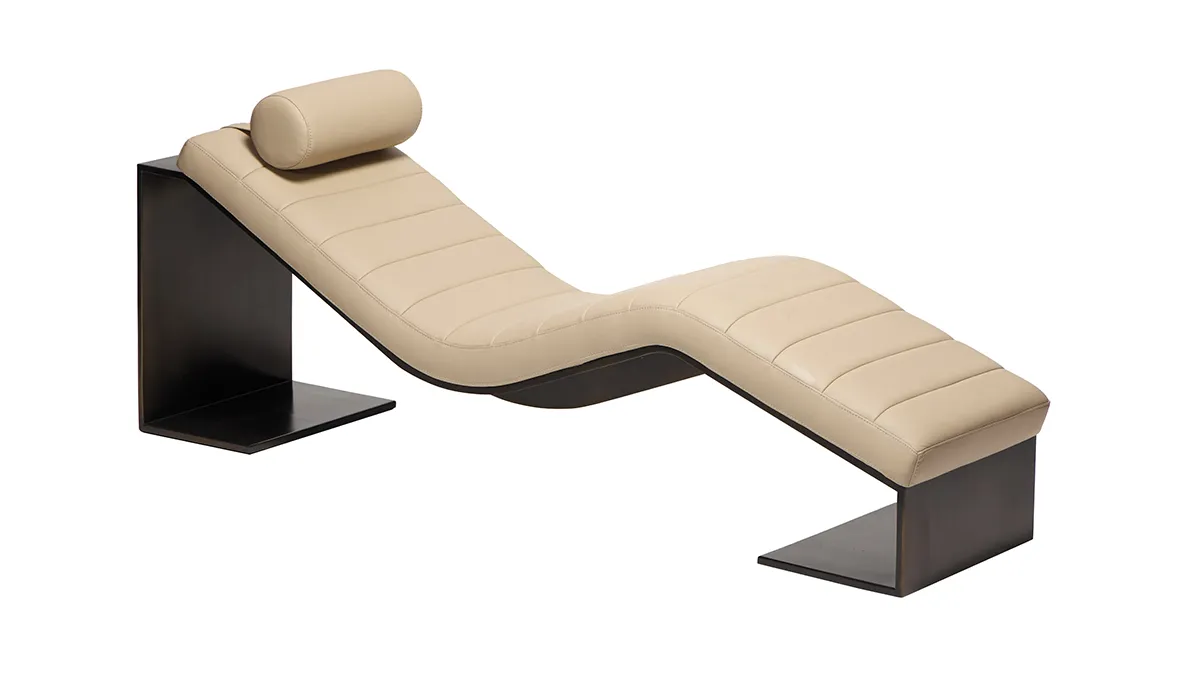
Kimani, Reda Amalou Design
French architect and designer Reda Amalou acknowledges the challenge of creating standout seating given the number of iconic 20th-century examples already in existence. Still, he persists—and prevails. The Kimani, a bent slash of a daybed in a limited edition of eight pieces, makes a forceful statement. Its leather cushion features a rolled headrest and rhythmic channel stitching reminiscent of that found on the seats of ’70s cars; visually, these elements anchor the slender silhouette atop a patinated bronze base with a sure-handed single line. The result: a seamless contour for the body. Around $33,530; RedaAmalou
Dune, Workshop/APD
From a firm known for crafting subtle but luxurious architecture and interiors, Workshop/APD’s debut furniture collection is on point. Among its offerings is the leather-wrapped Dune daybed. With classical and Art Deco influences, its cylindrical bolsters are a tactile celebration, and the peek of the curved satin-brass base makes for a sensual surprise. Associate principal Andrew Kline notes that the daybed adeptly bridges two seating areas in a roomy living space or can sit, bench-style, at the foot of a bed. From $13,040; Workshop/ APD
Sherazade, Edra
Designed by Francesco Binfaré, this sculptural, minimalist daybed—inspired by the rugs used by Eastern civilizations—allows for complete relaxation. Strength combined with comfort is the name of the game here. The Sherazade’s structure is made from light but sturdy honeycomb wood, while next-gen Gellyfoam and synthetic wadding aid repose. True to Edra’s amorphous design codes, it can switch configurations depending on the user’s mood or needs; for example, the accompanying extra pillows—one rectangular and one cylinder shaped— interchange to become armrests or backrests. From $32,900; Edra
You may also like.
By Josh Bozin
24/07/2024
22/07/2024
Watches & Wonders 2024 Showcase: Hermès
We head to Geneva for the Watches & Wonders exhibition; a week-long horological blockbuster featuring the hottest new drops, and no shortage of hype.
With Watches & Wonders 2024 well and truly behind us, we review some of the novelties Hermès presented at this year’s event.
—
HERMÈS
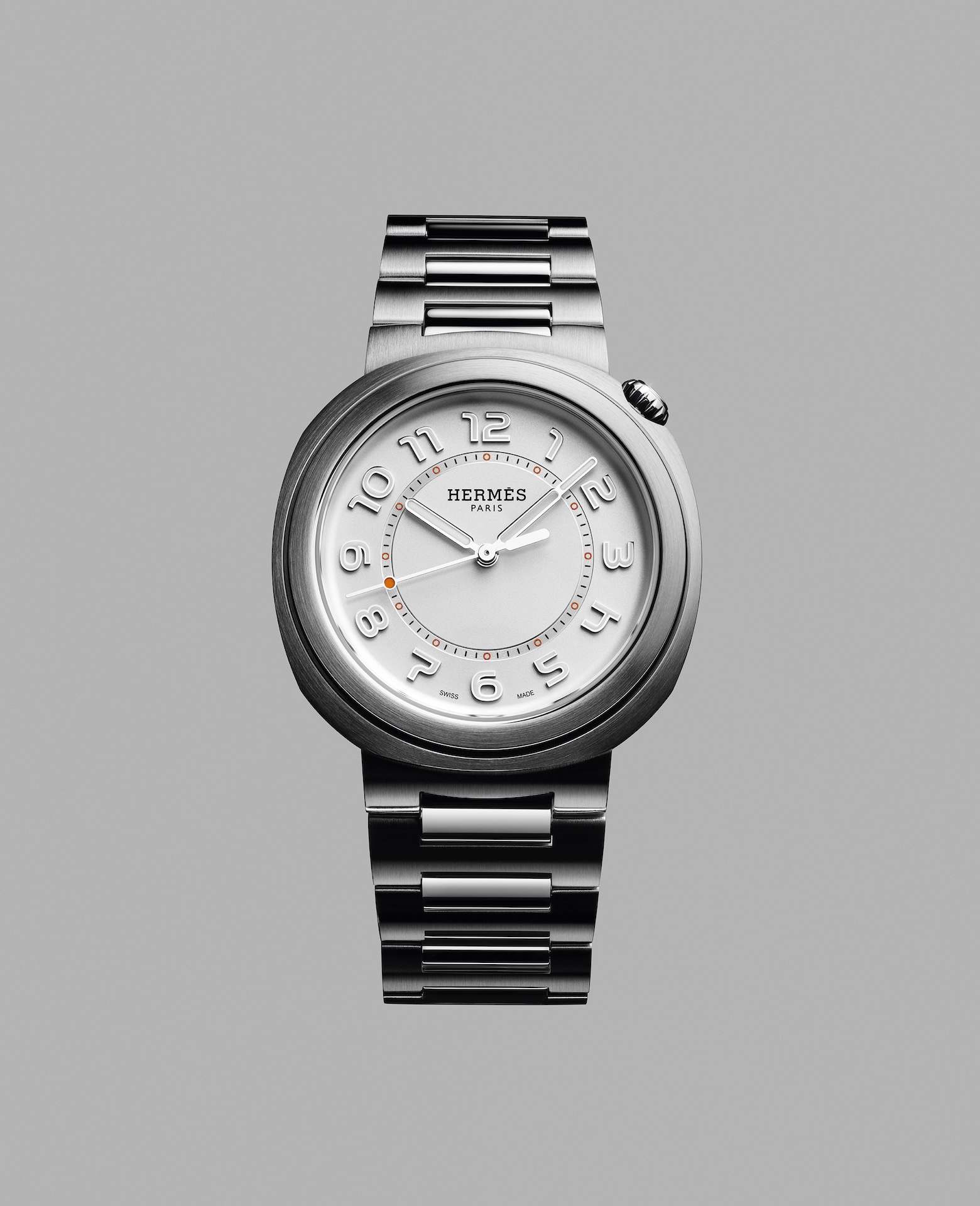
Moving away from the block colours and sporty aesthetic that has defined Hermès watches in recent years, the biggest news from the French luxury goods company at Watches & Wonders came with the unveiling of its newest collection, the Hermès Cut.
It flaunts a round bezel, but the case middle is nearer to a tonneau shape—a relatively simple design that, despite attracting flak from some watch aficionados, works. While marketed as a “women’s watch”, the Cut has universal appeal thanks to its elegant package and proportions. It moves away from the Maison’s penchant for a style-first product; it’s a watch that tells the time, not a fashion accessory with the ability to tell the time.
Hermès gets the proportions just right thanks to a satin-brushed and polished 36 mm case, PVD-treated Arabic numerals, and clean-cut edges that further accentuate its character. One of the key design elements is the positioning of the crown, boldly sitting at half-past one and embellished with a lacquered or engraved “H”, clearly stamping its originality. The watch is powered by a Hermès Manufacture movement H1912, revealed through its sapphire crystal caseback. In addition to its seamlessly integrated and easy-wearing metal bracelet, the Cut also comes with the option for a range of coloured rubber straps. Together with its clever interchangeable system, it’s a cinch to swap out its look.
It will be interesting to see how the Hermès Cut fares in coming months, particularly as it tries to establish its own identity separate from the more aggressive, but widely popular, Ho8 collection. Either way, the company is now a serious part of the dialogue around the concept of time.
—
Read more about this year’s Watches & Wonders exhibition at robbreport.com.au
You may also like.
22/07/2024
Living La Vida Lagerfeld
The world remembers him for fashion. But as a new tome reveals, the iconoclastic designer is defined as much by extravagant, often fantastical, homes as he is clothes.
“Lives, like novels, are made up of chapters”, the world-renowned bibliophile, Karl Lagerfeld, once observed.
Were a psychological-style novel ever to be written about Karl Lagerfeld’s life, it would no doubt give less narrative weight to the story of his reinvigoration of staid fashion houses like Chloe, Fendi and Chanel than to the underpinning leitmotif of the designer’s constant reinvention of himself.
In a lifetime spanning two centuries, Lagerfeld made and dropped an ever-changing parade of close friends, muses, collaborators and ambiguous lovers, as easily as he changed his clothes, his furniture… even his body. Each chapter of this book would be set against the backdrop of one of his series of apartments, houses and villas, whose often wildly divergent but always ultra-luxurious décor reflected the ever-evolving personas of this compulsively public but ultimately enigmatic man.
With the publication of Karl Lagerfeld: A Life in Houses these wildly disparate but always exquisite interiors are presented for the first time together as a chronological body of work. The book indeed serves as a kind of visual novel, documenting the domestic dreamscapes in which the iconic designer played out his many lives, while also making a strong case that Lagerfeld’s impact on contemporary interior design is just as important, if not more so, than his influence on fashion.
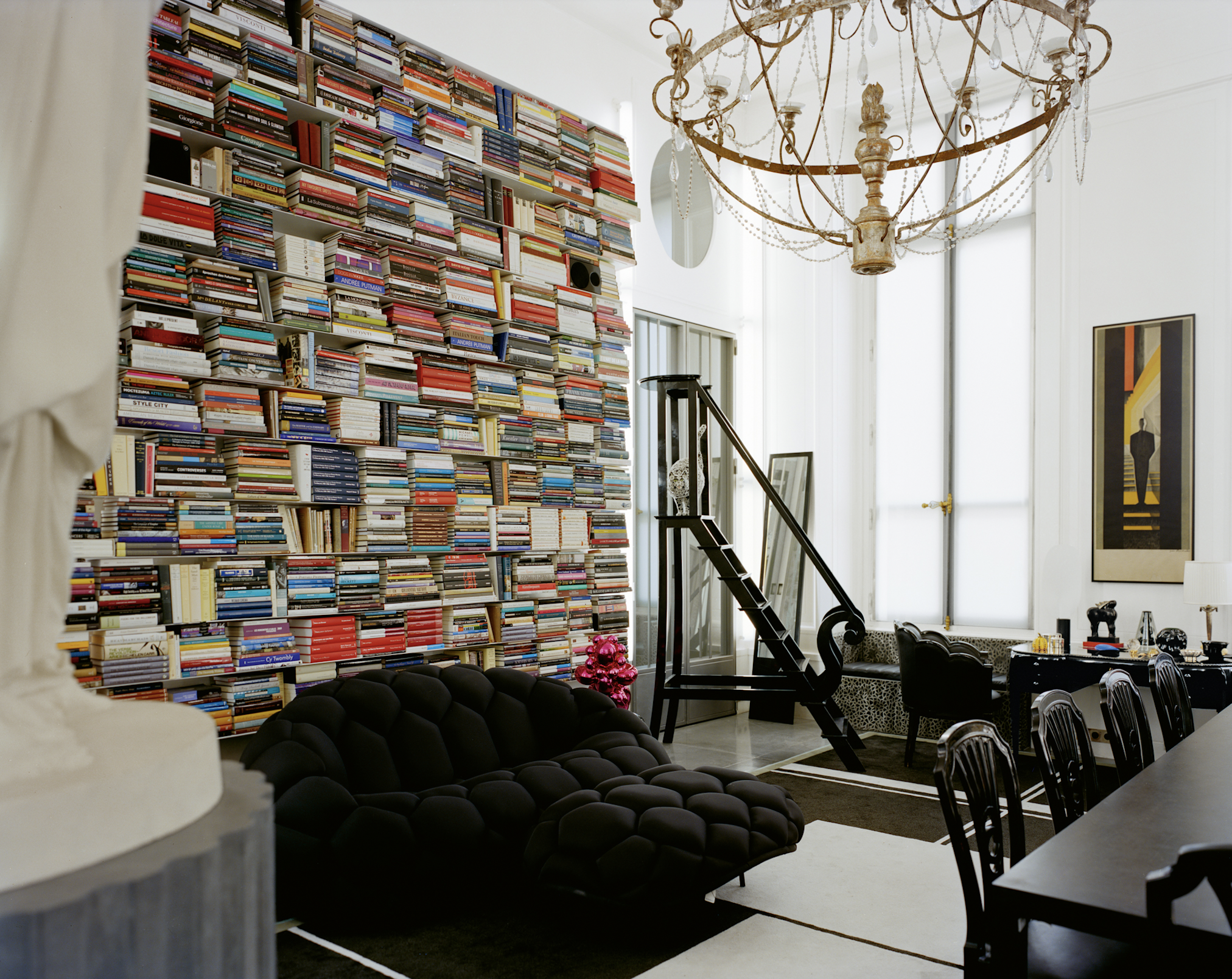
In fact, when the first Lagerfeld interior was featured in a 1968 spread for L’OEil magazine, the editorial describes him merely as a “stylist”. The photographs of the apartment in an 18th-century mansion on rue de Université, show walls lined with plum-coloured rice paper, or lacquered deepest chocolate brown in sharp contrast to crisp, white low ceilings that accentuated the horizontality that was fashionable among the extremely fashionable at the time. Yet amid this setting of aggressively au courant modernism, the anachronistic pops of Art Nouveau and Art Deco objects foreshadow the young Karl’s innate gift for creating strikingly original environments whose harmony is achieved through the deft interplay of contrasting styles and contexts.
Lagerfeld learned early on that presenting himself in a succession of gem-like domestic settings was good for crafting his image. But Lagerfeld’s houses not only provided him with publicity, they also gave him an excuse to indulge in his greatest passion. Shopping!
By 1973, Lagerfeld was living in a new apartment at Place Saint–Sulpice where his acquisition of important Art Deco treasures continued unabated. Now a bearded and muscular disco dandy, he could most often be found in the louche company of the models, starlets and assorted hedonistic beauties that gathered around the flamboyant fashion illustrator Antonio Lopez. Lagerfeld was also in the throes of a hopeless love affair with Jacques de Bascher whose favours he reluctantly shared with his nemesis Yves Saint Laurent.
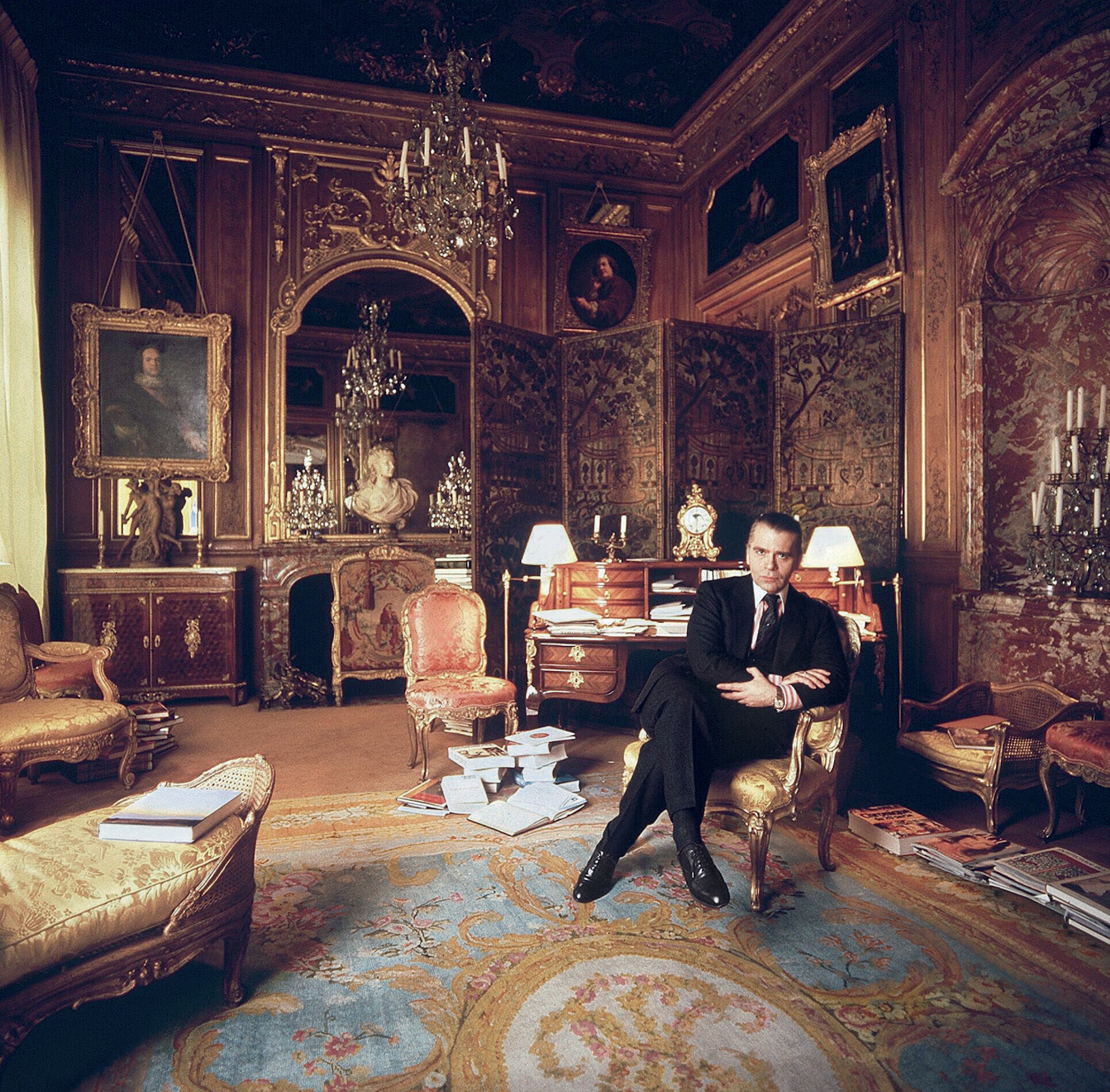
He painted the rooms milky white and lined them with specially commissioned carpets—the tawny patterned striations of which invoked musky wild animal pelts. These lent a stark relief to the sleek, machine-age chrome lines of his Deco furnishings. To contemporary eyes it remains a strikingly original arrangement that subtly conveys the tensions at play in Lagerfeld’s own life: the cocaine fuelled orgies of his lover and friends, hosted in the pristine home of a man who claimed that “a bed is for one person”.
In 1975, a painful falling out with his beloved Jacques, who was descending into the abyss of addiction, saw almost his entire collection of peerless Art Deco furniture, paintings and objects put under the auctioneer’s hammer. This was the first of many auction sales, as he habitually shed the contents of his houses along with whatever incarnation of himself had lived there. Lagerfeld was dispassionate about parting with these precious goods. “It’s collecting that’s fun, not owning,” he said. And the reality for a collector on such a Renaissance scale, is that to continue buying, Lagerfeld had to sell.
Of all his residences, it was the 1977 purchase of Hôtel Pozzo di Borgo, a grand and beautifully preserved 18th-century house, that would finally allow him to fulfill his childhood fantasies of life in the court of Madame de Pompadour. And it was in this aura of Rococó splendour that the fashion designer began to affect, along with his tailored three-piece suits, a courtier’s ponytailed and powdered coif and a coquettish antique fan: marking the beginning of his transformation into a living, breathing global brand that even those with little interest in fashion would immediately recognise.
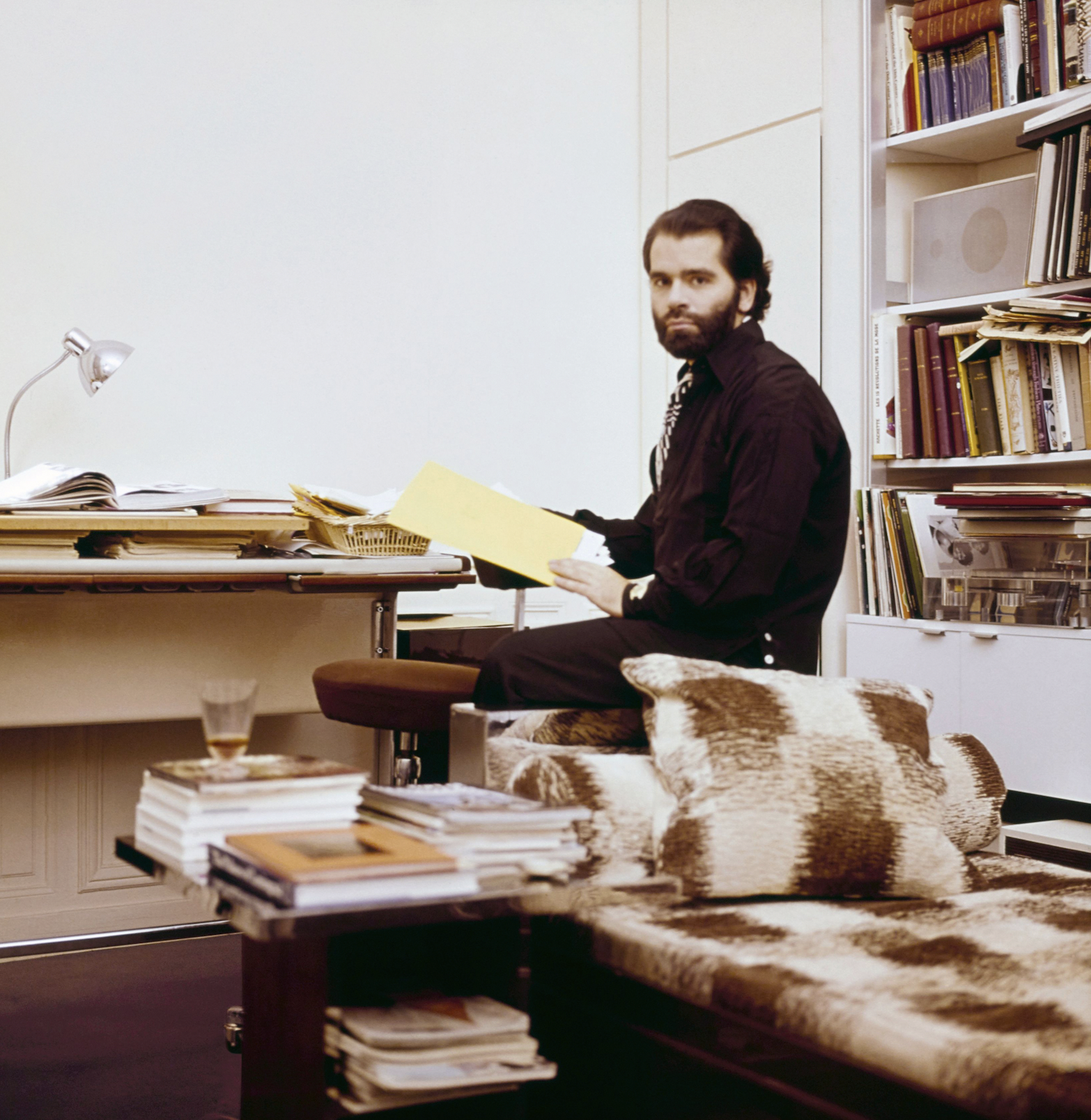
Lagerfeld’s increasing fame and financial success allowed him to indulge in an unprecedented spending frenzy, competing with deep-pocketed institutions like the Louvre to acquire the finest, most pedigreed pearls of the era—voluptuously carved and gilded bergères; ormolu chests; and fleshy, pastel-tinged Fragonard idylls—to adorn his urban palace. His one-time friend André Leon Talley described him in a contemporary article as suffering from “Versailles complex”.
However, in mid-1981, and in response to the election of left-wing president, François Mitterrand, Lagerfeld, with the assistance of his close friend Princess Caroline, became a resident of the tax haven of Monaco. He purchased two apartments on the 21st floor of Le Roccabella, a luxury residential block designed by Gio Ponti. One, in which he kept Jacques de Bascher, with whom he was now reconciled, was decorated in the strict, monochromatic Viennese Secessionist style that had long underpinned his aesthetic vocabulary; the other space, though, was something else entirely, cementing his notoriety as an iconoclastic tastemaker.
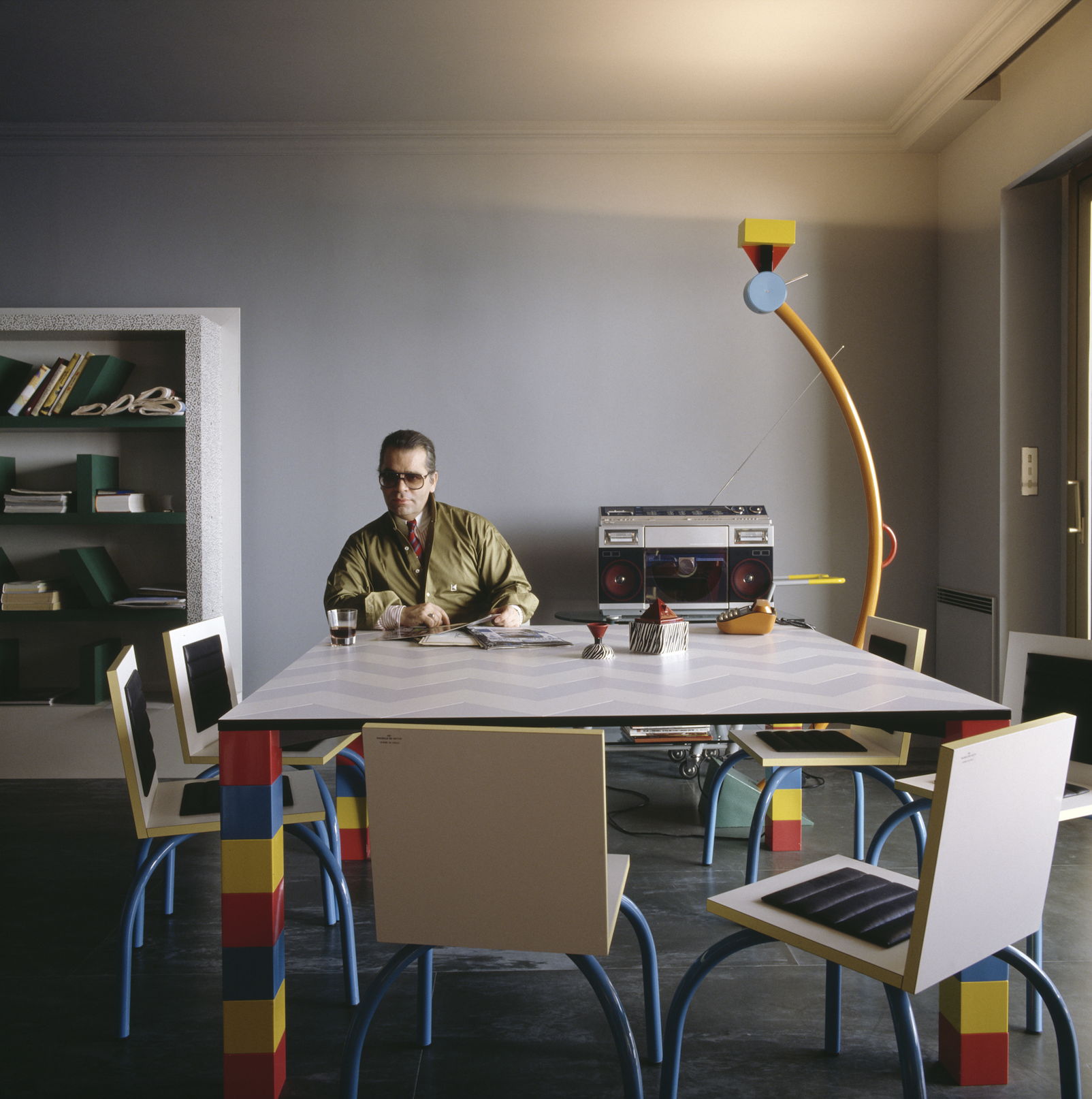
Lagerfeld had recently discovered the radically quirky designs of the Memphis Group led by Ettore Sottsass, and bought the collective’s entire first collection and had it shipped to Monaco. In a space with no right angles, these chaotically colourful, geometrically askew pieces—centred on Masanori Umeda’s famous boxing ring—gave visitors the disorientating sensation of having entered a corporeal comic strip. By 1991, the novelty of this jarring postmodern playhouse had inevitably worn thin and once again he sent it all to auction, later telling a journalist that “after a few years it was like living in an old Courrèges. Ha!”

In 1989, de Bascher died of an AIDS-related illness, and while Lagerfeld’s career continued to flourish, emotionally the famously stoic designer was struggling. In 2000, a somewhat corpulent Lagerfeld officially ended his “let them eat cake” years at the Hôtel Pozzo di Borgo, selling its sumptuous antique fittings in a massive headline auction that stretched over three days. As always there were other houses, but now with his longtime companion dead, and his celebrity metastasising making him a target for the paparazzi, he began to look less for exhibition spaces and more for private sanctuaries where he could pursue his endless, often lonely, work.
His next significant house was Villa Jako, named for his lost companion and built in the 1920s in a nouveau riche area of Hamburg close to where he grew up. Lagerfeld shot the advertising campaign for Lagerfeld Jako there—a fragrance created in memorial to de Bascher. The house featured a collection of mainly Scandinavian antiques, marking the aesthetic cusp between Art Nouveau and Art Deco. One of its rooms Lagerfeld decorated based on his remembrances of his childhood nursery. Here, he locked himself away to work—tellingly—on a series of illustrations for the fairy tale, The Emperor’s New Clothes. Villa Jako was a house of deep nostalgia and mourning.
But there were more acts—and more houses—to come in Lagerfeld’s life yet. In November 2000, upon seeing the attenuated tailoring of Hedi Slimane, then head of menswear at Christian Dior, the 135 kg Lagerfeld embarked on a strict dietary regime. Over the next 13 months, he melted into a shadow of his former self. It is this incarnation of Lagerfeld—high white starched collars; Slimane’s skintight suits, and fingerless leather gloves revealing hands bedecked with heavy silver rings—that is immediately recognisable some five years after his death.
The 200-year-old apartment in Quái Voltaire, Paris, was purchased in 2006, and after years of slumber Lagerfeld—a newly awakened Hip Van Winkle—was ready to remake it into his last modernist masterpiece. He designed a unique daylight simulation system that meant the monochromatic space was completely without shadows—and without memory. The walls were frosted and smoked glass, the floors concrete and silicone; and any hint of texture was banned with only shiny, sleek pieces by Marc Newson, Martin Szekely and the Bouroullec Brothers permitted. Few guests were allowed into this monastic environment where Lagerfeld worked, drank endless cans of Diet Coke and communed with Choupette, his beloved Birman cat, and parts of his collection of 300,000 books—one of the largest private collections in the world.
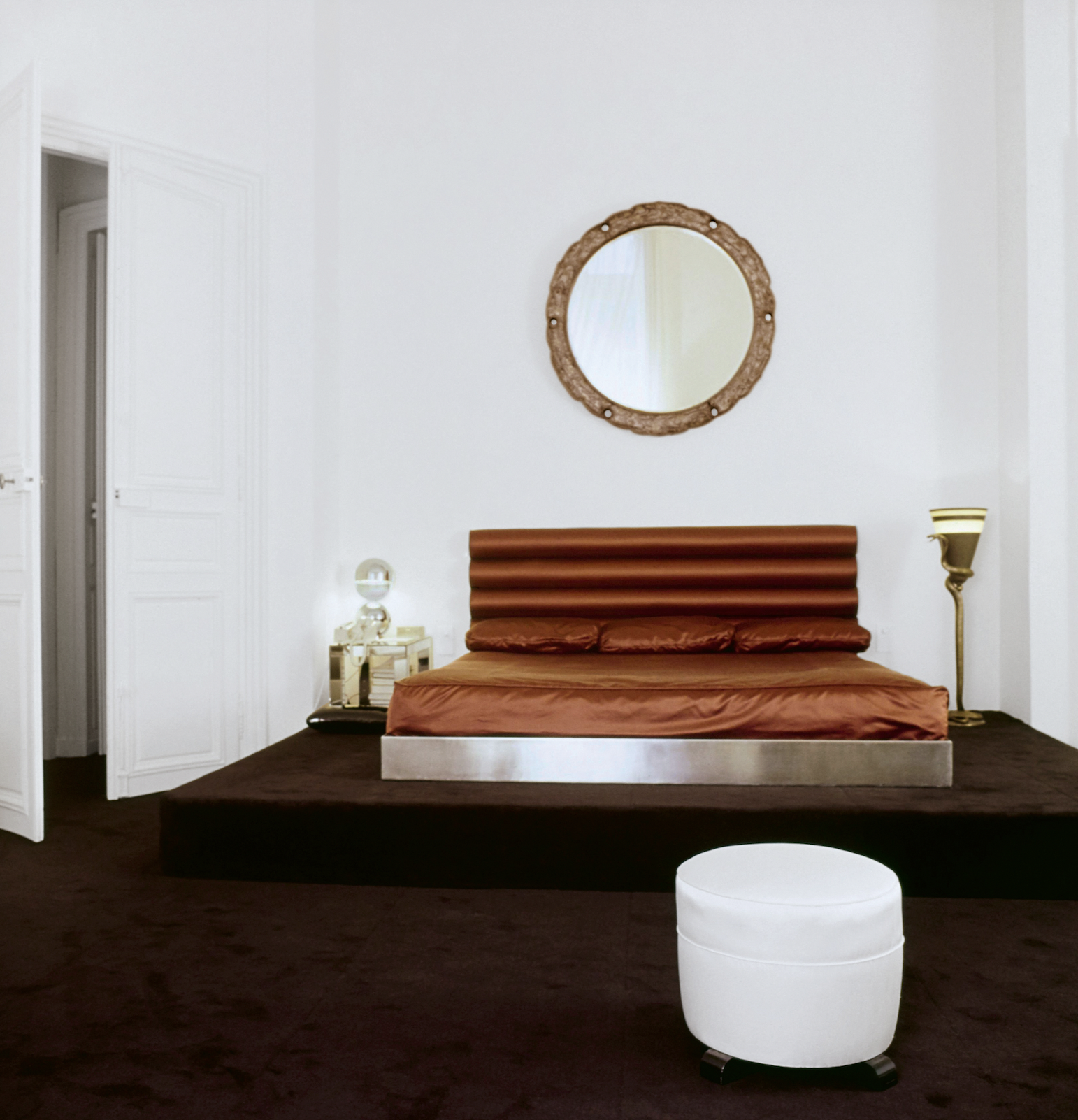
Lagerfeld died in 2019, and the process of dispersing his worldly goods is still ongoing. The Quái Voltaire apartment was sold this year for US$10.8 million (around $16.3 million). Now only the rue de Saint-Peres property remains within the Lagerfeld trust. Purchased after Quái Voltaire to further accommodate more of his books—35,000 were displayed in his studio alone, always stacked horizontally so he could read the titles without straining his neck—and as a place for food preparation as he loathed his primary living space having any trace of cooking smells. Today, the rue de Saint-Peres residence is open to the public as an arts performance space and most fittingly, a library.
You may also like.
By Josh Bozin
24/07/2024
Watch This Space: Mike Nouveau
Meet the game-changing horological influencers blazing a trail across social media—and doing things their own way.
In the thriving world of luxury watches, few people own a space that offers unfiltered digital amplification. And that’s precisely what makes the likes of Brynn Wallner, Teddy Baldassarre, Mike Nouveau and Justin Hast so compelling.
These thought-provoking digital crusaders are now paving the way for the story of watches to be told, and shown, in a new light. Speaking to thousands of followers on the daily—mainly via TikTok, Instagram and YouTube—these progressive commentators represent the new guard of watch pundits. And they’re swaying the opinions, and dollars, of the up-and-coming generations who now represent the target consumer of this booming sector.
—
MIKE NOUVEAU

Can we please see what’s on the wrist? That’s the question that catapulted Mike Nouveau into watch stardom, thanks to his penchant for highlighting incredibly rare timepieces across his TikTok account of more than 400,000 followers. When viewing Nouveau’s attention-grabbing video clips—usually shot in a New York City neighbourhood—it’s not uncommon to find him wrist-rolling some of the world’s rarest timepieces, like the million-dollar Cartier Cheich (a clip he posted in May).
But how did someone without any previous watch experience come to amass such a cult following, and in the process gain access to some of the world’s most coveted timepieces? Nouveau admits had been a collector for many years, but moved didn’t move into horology full-time until 2020, when he swapped his DJing career for one as a vintage watch specialist.
“I probably researched for a year before I even bought my first watch,” says Nouveau, alluding to his Rolex GMT Master “Pepsi” ref. 1675 from 1967, a lionised timepiece in the vintage cosmos. “I would see deals arise that I knew were very good, but they weren’t necessarily watches that I wanted to buy myself. I eventually started buying and selling, flipping just for fun because I knew how to spot a good deal.”
Nouveau claims that before launching his TikTok account in the wake of Covid-19, no one in the watch community knew he existed. “There really wasn’t much watch content, if any, on TikTok before I started posting, especially talking about vintage watches. There’s still not that many voices for vintage watches, period,” says Nouveau. “It just so happens that my audience probably skews younger, and I’d say there are just as many young people interested in vintage watches as there are in modern watches.”
View this post on Instagram
Nouveau recently posted a video to his TikTok account revealing that the average price of a watch purchased by Gen Z is now almost US$11,000 (around $16,500), with 41 percent of them coming into possession of a luxury watch in the past 12 months.
“Do as much independent research as you can [when buying],” he advises. “The more you do, the more informed you are and the less likely you are to make a mistake. And don’t bring modern watch expectations to the vintage world because it’s very different. People say, ‘buy the dealer’, but I don’t do that. I trust myself and myself only.”
—
Read more about the influencers shaking up horology here with Justin Hast, Brynn Wallner and Teddy Baldassare.
You may also like.
By Josh Bozin
24/07/2024
This Pristine 1960 Ferrari 250 Spider Could Fetch $24 Million at Auction
The car wears the same colours and has the same engine it left the factory with.
Some Ferraris are just a little bit more important than others.
Take, for example, the 1960 250 GT SWB California that RM Sotheby’s is auctioning off during this year’s Monterey Car Week. Any example of the open-top beauty would attract interest, but this one just so happens to be the first one that was built.
The 250 is one of the most legendary series of cars in Ferrari history. Between 1952 and 1964, the company released 21 different 250 models—seven for racetracks, 14 for public roads—of which the “Cali Spider” might be the most well regarded, thanks to its potent V-12 and a Pininfarina-penned design that is one of the most beautiful bodies to grace an automobile. The roadster, which was specifically built for the U.S., made its debut in 1957 as a long-wheel-base model (LWB), but it wasn’t until the SWB model debut in 1960 that it became clear how special it was. This example isn’t just the first to roll off the line. It’s the actual car that was used to introduce the world to the model at the 1960 Geneva Motor Show.
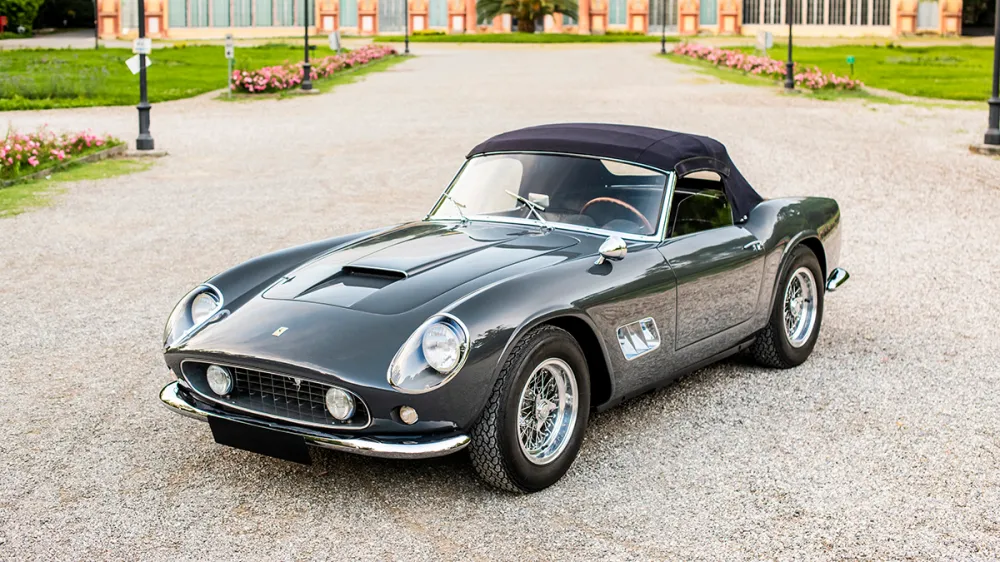
Just 56 examples of the 250 GT SWB California Spider would be built by Scaglietti during the three years it was in production. The first of those, chassis 1795 GT, is finished in a glossy coat of Grigio. The two-door had a red leather interior at Geneva but was returned to the factory and re-outfitted with black leather upholstery before being delivered to its original owner, British race car driver John Gordon Bennet. Six-and-a-half decades later the car looks identical to how it did when it left the factory the second time.
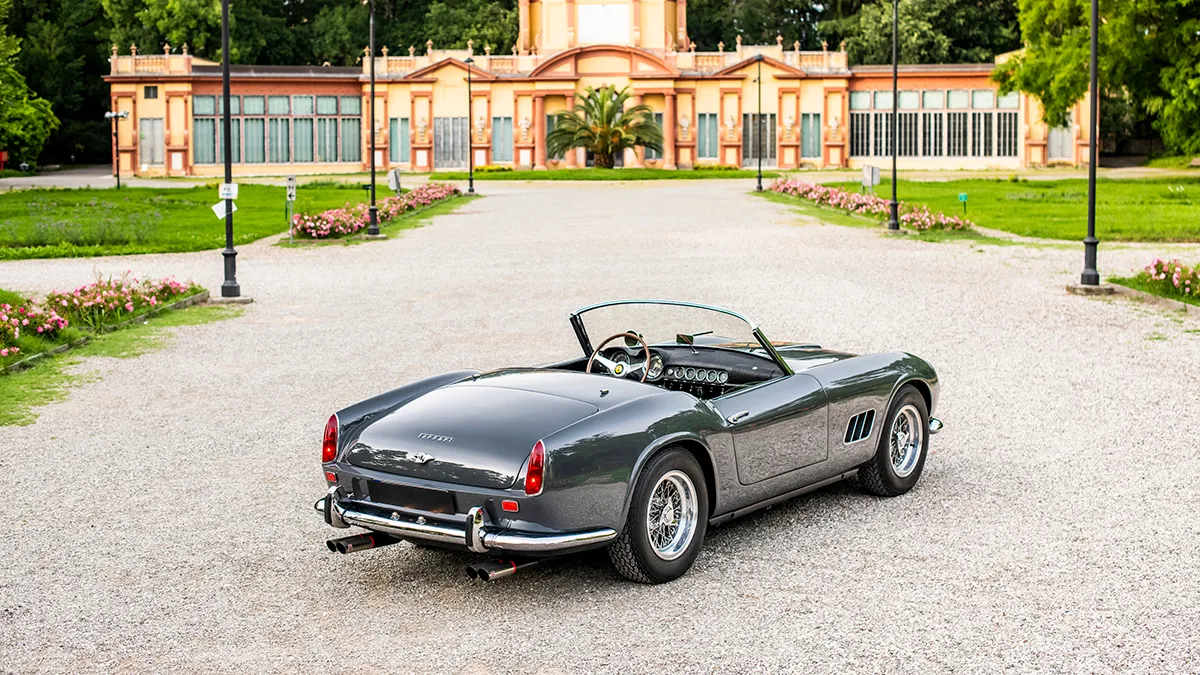
In addition to its original bodywork, the chassis 1795 GT features its original engine, gearbox, and rear axle. That mill is the competition-spec Tipo 168, a 3.0-litre V-12 that makes 196.1 kW. That may not sound like much by today’s standards, but, when you consider that the 250 GT SWB California Spider tips the scales around 952 kilograms, it’s more than enough.
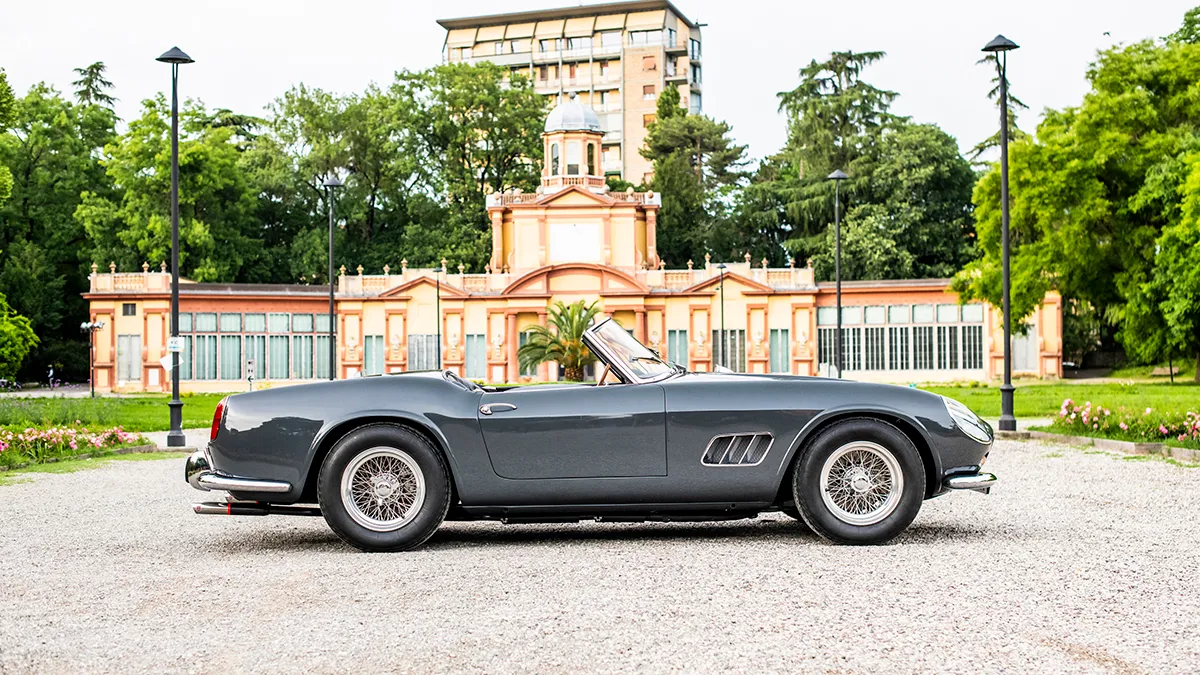
The first 250 GT SWB California Spider is scheduled to go up for bid during RM Sotheby’s annual Monterey Car Week auction, which runs from Thursday, August 15, to Saturday, August 17. Unsurprisingly, the house has quite high hopes for the car. The car carries an estimate of between $24 million and $26 million, which could make it one of the most expensive cars ever sold at auction.
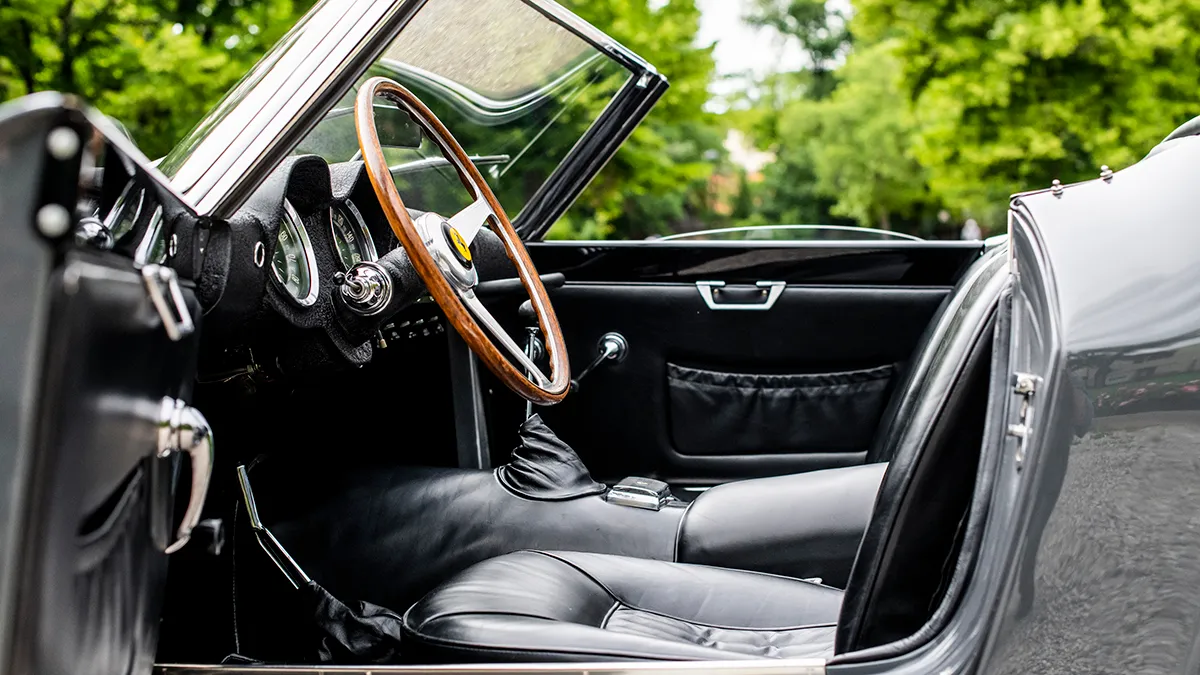
You may also like.
By Josh Bozin
24/07/2024






